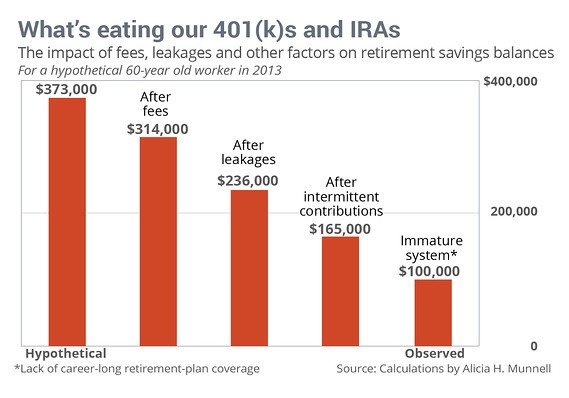The hidden costs of 401(k) loans Encore
Post on: 16 Март, 2015 No Comment

By Anne Tergesen
As banks have cut back on lending in the wake of the financial crisis, the number of people who have turned to their 401(k) accounts as a source of credit has risen . Now, new research by mutual fund giant Fidelity Investments quantifies just how harmful those loans can be to 401(k) participants.
Shutterstock.com
On the surface, 401(k) loans sound benign. After all, 96% of such loans—taken by one in nine 401(k) participants over the past year—are repaid, says Jeanne Thompson, vice president of market insights at Fidelity. (On average, loans at the 20,600 401(k) plans Fidelity examined were repaid over three-and-a-half years.)
But those statistics don’t tell the whole story.
First, for the 4% who default on these loans—which average $9,000—the consequences can be ugly. Those who leave their jobs—either voluntarily or not—must typically repay the outstanding balance within 60 days, or face an income tax bill on the defaulted amount. (Those under 59 ½ also incur a 10% penalty.)
But the Fidelity research highlights the hidden costs of such loans even for those who repay them:
• Those who take loans tend to decrease their savings rates—from an average of 8.4% to 6.5%, according to Fidelity. This allows them to better afford the repayments, which are automatically deducted from their paychecks (along with their 401(k) contributions). Fidelity followed people who took out loans and found that it took two years, on average, before their savings rates were restored to the levels that had prevailed before the loans. “Three-plus years of contributions at a lower rate can impact retirement savings,” Thompson says.
• When you repay a loan, you do so with after-tax money. The worst part: You must pay tax on the money again when you withdraw it in retirement.
• Many employers assess loan fees.

Fidelity says it has recently noticed a trend towards serial borrowing, which can be especially detrimental to retirement security. The company estimates that someone who contributes 10% of salary to a 401(k) plan will have $364,000 after 10 years, versus $313,000 for someone who contributes 13% but takes $117,000 in a series of loans. Moreover, 10% of borrowers go on to take a hardship withdrawal, which creates a “triple whammy,” Thompson says. The reason: Hardship withdrawals cannot be repaid, are subject to income tax (and, for borrowers under 59 ½, a 10% penalty) and impose a six-month moratorium on new 401(k) contributions.
Thompson says some employers are taking steps to discourage serial loans. For example, some now only allow employees to take one 401(k) loan at a time and impose a six-month wait period between loans. Many only allow employees to borrow from their own contributions—the employer match is off-limits.
For employees, the takeaway is “to build emergency savings” to have something other than a 401(k) plan to fall back on in the event of a financial crisis, Thompson says.
Mid-life joblessness puts women at risk Next
Investor protection bill interferes with better efforts














